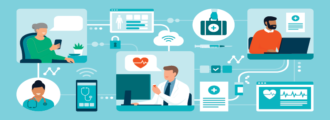In today’s rapidly evolving healthcare landscape, the seamless exchange of patient data is crucial for efficient and effective patient care. Health Level Seven (HL7) standards are pivotal in enabling interoperability among healthcare providers and transforming the way electronic health records are shared across diverse systems.
But what exactly are these standards, and why are they so important?
This blog post will provide an overview of HL7 standards, their key components, the latest advancements such as Fast Healthcare Interoperability Resources (FHIR), and the future of these standards in shaping the exchange of data related to healthcare.
Key Takeaways
- HL7 data standards are essential for promoting and achieving interoperability and improved care delivery in healthcare and clinical practice.
- HL7 standards comprise messaging standards, data formats, and clinical/administrative data to enable the exchange of consistent data.
- Healthcare organizations play a key role in developing & implementing HL7 standards to ensure efficient patient care with upcoming innovations such as FHIR 4.0.1 & USCDI versions 2&3
What is an HL7 Standard?
HL7 standards are regulations for organizing electronic health information, allowing for effortless information transfer between systems and enhancing patient administration and care. These standards enable interoperability between health information systems used by healthcare providers and reduce the administrative burden on healthcare executives and other internal staff members.
HL7 standards, a comprehensive guide for compiling clinical information and rules for structuring data, help facilitate the flow of information between systems where healthcare providers store their data.
The importance and evolution of HL7 protocol standards have shaped today’s healthcare systems, promoting seamless data swaps and improving patient care across various healthcare providers. As the standards evolve, they continuously adapt to new technologies, offering enhanced efficiency and versatility for patient data exchange in health services.
The Importance of HL7 Standards
HL7 are the primary standards used in healthcare for messaging and interoperability. By facilitating the maintenance of consistent electronic health information and the Clinical Document Architecture standard across all systems, HL7 standards enable a more organized approach to data management in healthcare.
Implementing these standards allows for automation and streamlined workflows in multi-application environments used by various healthcare providers. The significance of HL7 standards lies in their capacity to foster interoperability, ensure consistent documentation, and enhance care across healthcare systems.
Evolution of HL7 Standards
The history of HL7 healthcare standards dates back to the late 1970s when its precursor was developed at the University of California at San Francisco (UCSF) Medical Center. Since then, HL7 International, a non-profit organization, has crafted numerous standards widely adopted in the United States and globally, allowing healthcare organizations to share data more efficiently.
Fast Healthcare Interoperability Resources (FHIR) is the latest version of HL7, offering increased efficiency and versatility for data exchange in health services. Despite the challenges presented by HL7 standards, like integration issues and the need for adaptation to emerging technologies, they remain the primary standards for data swaps in healthcare.
Upcoming developments in HL7 standards include the use of artificial intelligence, machine learning, and the active role of healthcare organizations in their progression and implementation.
Key Components of HL7 Standards
HL7 standards encompass messaging standards, data formats, and clinical and administrative data, facilitating uniform data creation and sharing. Each key component significantly contributes to the overall structure and function of HL7 interface standards, ensuring the consistency and accessibility of data in healthcare across various systems.
Here’s a closer look at the most critical components that comprise HL7 standards:
Messaging Standard
Messaging standards in HL7 facilitate communication between Electronic Health Records (EHRs) and other healthcare systems. The messaging standard of HL7 standards is HL7 version 3. However, HL7 v2 & 3 message formats have been demonstrated to be either too unstructured or too restrictive in scope to be applicable to all clinical applications.
The importance of messaging standards in HL7 lies in their ability to provide a common language for healthcare systems to communicate effectively. Messaging standards, which establish a standard protocol for information transmission, ensure data can be easily shared and interpreted by different healthcare providers.
Data Formats
Data formats in HL7 offer a standard structure for data in healthcare, thereby minimizing fragmentation issues. HL7 messages are available in human-readable (ASCII) form, while XML schemas are used for HL7 v3 messages.
Data formats in HL7 standards, which provide a consistent structure for date in healthcare, significantly minimize discrepancies and confusion. This consistency ensures that healthcare data can be easily accessed and interpreted by various healthcare providers, ultimately leading to improved the care of patients.
Administrative and Clinical Data
Clinical and administrative data in HL7 facilitate various aspects of healthcare, such as quality measurement and decision-making. HL7 standards enable the exchange of clinical and administrative health data between applications.
Including administrative and clinical data within HL7 standards supports a wide range of healthcare needs, from patient care to billing and reporting. HL7 standards, ensuring consistently structured data that can be easily shared between different systems, promote more efficient and accurate healthcare delivery.
Fast Healthcare Interoperability Resources (FHIR)
FHIR is a contemporary HL7 standard that emphasizes facilitating data sharing, decreasing the burden, and conforming to other healthcare standards.
FHIR combines the most advantageous features of prior standards into a unified specification while remaining flexible enough to suit the requirements of various use cases within the healthcare environment. FHIR concentrates on implementation and employs the most recent web technologies to facilitate rapid acceptance.
FHIR is a key standard that facilitates efficient and secure interoperability. FHIR, providing a standard approach for representing and exchanging information between clinicians and organizations, ensures accessibility and consistency of healthcare data, regardless of how local EHRs store and represent the data.
FHIR Capabilities
FHIR provides various capabilities, including the Clinical Reasoning Module, which allows better clinical decision support and quality measurement.
The Clinical Reasoning Module in FHIR offers a range of features, including:
- Clinical decision support rules
- Clinical quality measurement and reporting
- Order sets
- Other capabilities to evaluate the healthcare process both prospectively and retrospectively.
The Clinical Reasoning Module in FHIR, offering various capabilities, enhances care during service and allows for post-service care assessment. This improvement over prior care improvement standards demonstrates the potential of FHIR in transforming healthcare data exchange and decision-making.
FHIR Profiles and Implementation Guides
FHIR Profiles and Implementation Guides offer customized solutions to meet specific needs, promoting effective data exchange and reporting. A FHIR Profile is a customized FHIR resource designed to fulfill a particular use case. A FHIR Profile is intended to provide structure and uniformity for targeted data elements in a given context, thus facilitating a data swap.
FHIR Profiles and Implementation Guides, offering tailored solutions for specific use cases, ensure the easy exchange and reporting of data across various systems. This adaptability helps healthcare providers meet the unique requirements of their healthcare organizations while maintaining a consistent approach to data management and exchange.
Overcoming Challenges with HL7 Standards
Challenges with HL7 FHIR standards include integration issues and evolving technologies, which require stricter rules, profiles, and stakeholder collaboration. Addressing these challenges allows healthcare organizations to harness the full potential of HL7 standards, achieving interoperability, improving patient care, and streamlining data swaps.
Integration Issues
Integration issues arise due to the flexibility of HL7 standards, leading to varying implementations and interpretations across healthcare organizations. These issues are characterized by the complexity of the HL7 standards, the requirement for stringent regulations, and the necessity for stakeholder collaboration.
To overcome these integration challenges, custom APIs and Integrating the Healthcare Enterprise (IHE) initiatives have been developed to facilitate seamless data exchange in healthcare between different systems. These solutions provide an additional layer of policies, aiding in reducing discrepancies and ensuring data consistency across healthcare organizations.
Evolving Technologies
Evolving technologies in healthcare require continuous updates and improvements in HL7 standards to maintain interoperability and efficiency. Current advancements with HL7 standards include FHIR and the integration of HL7 standards with other emerging healthcare technologies.
FHIR profiles and implementation guides can be utilized to integrate HL7 standards with emerging healthcare technologies. These profiles and principles provide a structure for the secure transmission of data between different systems.
As technology continues to evolve, so must HL7 standards, ensuring they remain relevant and effective in facilitating data exchange in healthcare.
The Future of HL7 Standards
The future of HL7 standards involves upcoming innovations, such as FHIR 4.0.1, and the active role of healthcare organizations in shaping the development of these standards.
As healthcare technology continues to evolve, adapting HL7 standards is vital to meeting the changing needs of healthcare providers and organizations, ensuring a secure and efficient exchange of patient data across various systems. Organizations are required to take a proactive approach to HL7 standards, participating in the development process.
Upcoming Innovations
Upcoming innovations in HL7 standards include FHIR 4.0.1, which aims to enhance secure and efficient patient data transmission and real-time clinical decision support. The ONC Cures Act Final Rule requires interoperability to be facilitated through the FHIR standard. This will lead to easier integration of applications and vendor systems in the years ahead with the help of HL7 FHIR.
In addition to FHIR 4.0.1, other advancements in HL7 standards include improvements to standards such as the United States Core Data for Interoperability (USCDI) version 2 and version 3, as well as collaborations with organizations like the World Health Organization (WHO) to promote the adoption of open interoperability standards around the world.
Role of Healthcare Organizations
Healthcare organizations play an integral role in the future of HL7 standards, participating in discussions around HL7, APIs, and FHIR while implementing these standards effectively. They are responsible for incorporating HL7 standards into their systems and healthcare workflows to ensure interoperability and the smooth exchange of health information.
Moreover, healthcare organizations collaborate with other stakeholders, such as software vendors and government agencies, to develop and update HL7 standards according to their needs and requirements. Active engagement in the development and evolution of HL7 standards allows healthcare organizations to ensure that these standards continue to meet the shifting needs of the healthcare industry and enhance patient care.
How Can We Help?
Whether you need help streamlining data management activities across your clinical practice or health system, additional support facilitating better data interoperability between healthcare technology systems, or just an extra hand keeping up with HL7 standards development over time, Surety Systems is here to help.
Our team of senior-level HL7 consultants has the skills, experience, and know-how to handle all your healthcare integration projects, no matter how simple or complex, big or small.
Getting Started with Us
Interested in learning how HL7 primary standards can improve data sharing and interoperability across systems or where our team of HL7 consultants can fit in your organization?
Contact us today to get started!
Frequently Asked Questions
What is the difference between HL7 and FHIR?
FHIR is an evolution of the HL7 standard, leveraging modern open web technologies such as RESTful web services and JSON to provide easier access and a broader range of coverage compared to HL7’s XML-only support.
FHIR is designed to enable healthcare providers to quickly and easily exchange data between systems, allowing for more efficient and effective care. It also provides a platform for developers to create applications that can access and use data in healthcare.
What is the significance of HL7?
Health Level Seven (HL7) is the international set of primary standards that facilitate this vital communication. HL7 is a key factor in providing better healthcare by allowing interoperability between providers and ensuring data-sharing standards.
Is FHIR a data standard?
Yes, FHIR is a data standard as it is an HL7® standard for exchanging health care information electronically, adopted by the health care community to advance interoperability.




